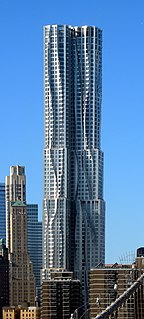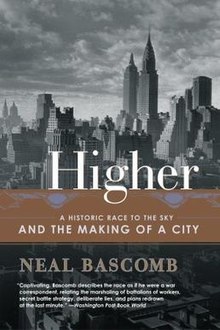
A skyscraper is a continuously habitable high-rise building that has over 40 floors and is taller than approximately 150 m (492 ft). Historically, the term first referred to buildings with 10 to 20 floors in the 1880s. The definition shifted with advancing construction technology during the 20th century. Skyscrapers may host offices, residential spaces, and retail spaces. For buildings above a height of 300 m (984 ft), the term supertall skyscrapers can be used, while skyscrapers reaching beyond 600 m (1,969 ft) are classified as megatall skyscrapers.

70 Pine Street – formerly known as the American International Building, 60 Wall Tower and originally as the Cities Service Building – is a 67-story, 952-foot (290 m) residential building located at the corner of Pearl Street and running to Cedar Street in the Financial District of Manhattan, New York City, New York, United States. It was built in 1931–32 by the Cities Service Company for the oil and gas baron Henry Latham Doherty, and was designed by the firm of Clinton & Russell, Holton & George in the Art Deco style.

40 Wall Street, also known as the Trump Building, is a 71-story neo-gothic skyscraper between Nassau Street and William Street in the Financial District of Manhattan, New York City. Erected by The Manhattan Company as its headquarters, the building was originally known as the Bank of Manhattan Trust Building, and also as the Manhattan Company Building, until its founding tenant merged to form the Chase Manhattan Bank. The structure was completed in 1930 after 11 months of construction.

Harold Craig Severance was an American architect who designed a number of well-known buildings in New York City, including the Coca-Cola Building, Nelson Tower and most prominently, 40 Wall Street.
The year 1930 in architecture involved some significant events.

The Chanin Building is a brick and terra-cotta skyscraper located at 122 East 42nd Street, at the corner of Lexington Avenue, in Midtown Manhattan, New York City. Built by Irwin S. Chanin in 1927–1929, it is 56 stories high, reaching 197.8 meters (649 ft) excluding the spire and 207.3 meters (680 ft) including it. It was designed by Sloan & Robertson in the Art Deco style, with the assistance of Chanin's own architect Jacques Delamarre, and it incorporates architectural sculpture by Rene Paul Chambellan. It is the 93rd tallest building in New York.
The Mile High Illinois, Illinois Sky-City, or simply The Illinois was a proposed skyscraper that is over 1 mile (1,600 m) high, conceived and described by American architect Frank Lloyd Wright in his 1957 book, A Testament. The design, intended to be built in Chicago, included 528 stories, with a gross area of 18,460,000 square feet (1,715,000 m2). Wright stated that there would have been parking for 15,000 cars and 100 helicopters.
John Evert Van Alen was an American surveyor, merchant, and politician from the U.S. state of New York. He served as a Federalist member of the United States House of Representatives.

The building form most closely associated with New York City is the skyscraper, which has shifted many commercial and residential districts from low-rise to high-rise. Surrounded mostly by water, the city has amassed one of the largest and most varied collection of skyscrapers in the world.

William Van Alen was an American architect, best known as the architect in charge of designing New York City's Chrysler Building (1928–30).
The tallest building in the world, as of 2019, is Burj Khalifa. The title of "world's tallest building" has been borne by various buildings, such as the Rouen Cathedral and the Empire State Building.

The Van Alen Building is a modern apartment and penthouse block on the seafront in Brighton, part of the English city of Brighton and Hove. It was named after William Van Alen, the architect of New York City's Chrysler Building and is designed as a 21st-century interpretation of the Art Deco and Streamline Moderne styles. It was completed in 2001.

8 Spruce Street, originally known as Beekman Tower and currently marketed as New York by Gehry, is a 76-story skyscraper designed by architect Frank Gehry in the New York City borough of Manhattan at 8 Spruce Street, between William and Nassau Streets, in Lower Manhattan, just south of City Hall Park and the Brooklyn Bridge.

The early skyscrapers were a range of tall commercial buildings built between 1884 and 1945, predominantly in the American cities of New York City and Chicago. Cities in the United States were traditionally made up of low-rise buildings, but significant economic growth after the Civil War and increasingly intensive use of urban land encouraged the development of taller buildings beginning in the 1870s. Technological improvements enabled the construction of fireproofed iron-framed structures with deep foundations, equipped with new inventions such as the elevator and electric lighting. These made it both technically and commercially viable to build a new class of taller buildings, the first of which, Chicago's 138-foot (42 m) tall Home Insurance Building, opened in 1885. Their numbers grew rapidly, and by 1888 they were being labelled skyscrapers.

Yasuo Matsui was a prominent 20th century Japanese American architect.

Art Deco architecture flourished in New York City during the 1920s and 1930s before largely disappearing after World War II. The style is found in government edifices, commercial projects, and residential buildings in all five boroughs. The architecture of the period was influenced not just by decorative arts influences from across the world, but also local zoning regulations.
















